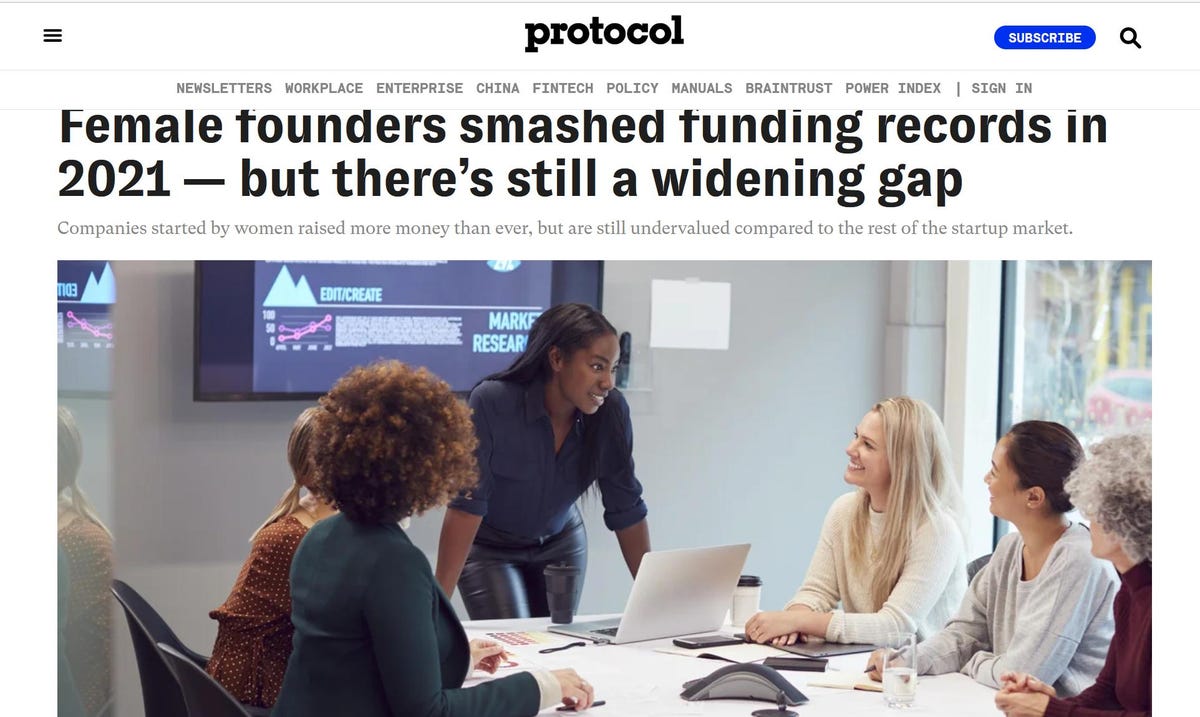
Female founders raising more, gap widens Protocol.com screenshot
Jenny Kassan, an attorney and entrepreneur focused on helping founders raise capital from “normal” investors, said on my Electric Ladies podcast recently that female founders, especially mission-focused ones, tend to limit who they think of as “investors” and miss out on a lot of money.
She said most women entrepreneurs think about venture capitalists (v.c.s), angels and so-called “friends and family” investors, but there are other options too.
Jenny Kassan
“There’s definitely bias in the venture industry, but …venture capitalists…like to invest in businesses that are on a very high growth path and have a plan for some kind of big what we call a liquidity event within ideally five to seven years,” Kassan explained. “Women entrepreneurs,” on the other hand, she said, “are more likely to start businesses that are not on that path.” Instead, “we prefer to maximize the benefits to all stakeholders and not just focus on that one goal of the big exit at any cost,” she said, adding that most angel investors are focused on the exit too.
If you’re mission-focused, Kassan explained, you’re even better positioned to raise funds from people who do not consider themselves “investors.”
“We just need to be more open-minded about who our potential investors are,” she added.
6 tips for raising funds – “Mostly it just takes a mindset shift”
All In report, Pitchbook Beyond the Billion, JP Morgan – Nov 2021
MORE FOR YOU
Here are tips from three masters at this: Kassan, Shelly Porges who is Managing Partner and Cofounder of Beyond the Billion (focused on increasing v.c. funding in female-founded companies and coauthor of the recent All Raise report from Pitchbook on these issues in 2021), and Julie Lenzer who is a serial entrepreneur and Chief Innovation Officer of the University of Maryland:
1. “Step one is getting clear on your goals and values because that will inform how you go about raising money”: Kassan focused on this clarity as step one because it drives all other decisions. If you want a quick exit, you’ll raise money one way, and if you are focused on a mission, you’ll likely do it another way, for example.
Lenzer pointed out that, “be(ing) clear in your mission, objectives and approach” will also “build confidence in others that you know what you’re doing.”
Julie Lenzer, Chief Innovation Officer, University of Maryland
2. Find investors in your network among people who share your values, create a partnership: Kassan insists, “there’s investors all over the place. In the United States, a majority of the adult population is investors.” They might be in your extended network, such as “people who are part of an organization that you’re involved with,” or a “really great place to look is your existing and potential customers, because those are people that are very likely to be passionate about what it is you’re building.” These investors might also be people who are aligned with the problem you’re solving, like climate change, “So anyone who’s passionate about climate change would be a great potential investor for you.”
“Mission alignment is key,” Lenzer wrote me this week too. “Connecting with investors who share your mission and objectives – tying to their ‘why’ – makes it more of a partnership than feeling like trying to sell them on what you’re doing.”
3. “Customize your offering to your particular situation,” which reduces the need to negotiate too: You won’t want to just use a standardized document off the web, Kassan stressed, adding that there are several important benefits to customizing. “What’s nice about that, is it really does send a message to your potential investors that you’re taking it really seriously. And you’re thinking it through given what you figured out in step one, your goals, your values, your plans, your projections,” she added.
In addition, when you do this, she believes, “you almost don’t have to negotiate,” though you’ll be open to counter-offers, your potential investors will see that “you’ve taken the time to think about this … what’s going to be healthiest for everyone involved.”
Shelly Porges, Managing Partner, Cofounder, Beyond the Billion
4. “Think big”: Porges told me that the biggest challenge she sees women entrepreneurs face is they don’t think about scaling, or about how big their market opportunity is. “You need to start thinking big and what that means is a couple of things: One is, how big is the market you’re going to address, and two is, how big is the problem you’re trying to solve.”
5. Know your numbers: The “biggest mistake” Porges sees female founders make is “not understanding their financials,” she told me. “When an investor looks at your financials, it tells them a story,” and you must understand what story it’s telling and “what it all means, and be able to track it on a regular basis.”
Know what your exit strategy is too, according to Lenzer, including when you expect it and estimate for how much.
Team Canada celebrates winning the women’s ice hockey gold medal game, Winter Olympic in Salt Lake … [+]
6. Build a strong team, including advisors: “Investors usually invest in the team first, idea second,” Lenzer emphasized, so make sure your team can do the work and grow the company. Porges also emphasized the importance of having strong advisors, that is, those in your industry and who can augment your team, filling in the skills your business needs but your core team may lack.
“The biggest problem that happens when women do start their own businesses”
Kassan has observed that “the biggest problem that happens when women do start their own businesses” is that. “they started on a shoestring.” But it takes money to start and grow a business, “to invest in things, to make sure it’s a healthy, successful business before you can really start to be profitable.”
You can’t do it all yourself. You don’t have all the skills, time and resources to do it all alone. If you try to do it all alone, “your customers probably won’t be super happy cause you won’t be able to give them the service that they would like to get” either.
The more you ask for the funds you need, Kassan, Porges and Lenzer all insisted, the easier it gets too.
To listen to Joan’s interview with Jenny Kassan, click here, to listen to Shelly Porges, click here, and to listen to Julie Lenzer, click here.







